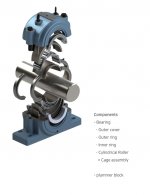Marco Schwan.
Plastic
- Joined
- Jan 18, 2020
Heyho!
I've recently posted about the restauration of my new(old) Ehrlich Lathe.
The one thing I didn't dissasemble and clean was the spindle itself.
I've done that now and it turns out its enough of a topic in itself for a new Thread.
Since you can only upload 5 pictures here I made an Imgur link with high-res versions of all Photos:
PHOTOS ---> Ehrlich Lathe Spindle Teardown - Album on Imgur <---
I also added some more notes by some of the Pictures.
An interesting feature of this spindle is beeing able to "select" between two speeds.
There is a knob on the big gear on the very right; if you pull that out it disengages the Flatbelt Pulley from the rest of the spindle. By flipping a tumbler on the headstock two more gears are engaged - which in turn results in a (roughly, need to measure it later) 10:1 reduction between pulley and spindle.
I'm assuming this is used for either very large work or thread cutting, since it reduces the speed to roughly 10rpm on the slowest setting.
Help request
Joe Michaels has posted a very nice, detailed instruction for setting the bushings properly, beeing tapered bronze bushings and all that.
I am going to tackle this next weekend, but nevertheless:
If any of you awesome people is living in Germany near Koblenz and would be willing to come over and help me a bit with setting the spindle up properly, - That would be just amazing, and greatly appreciated.
Either way I will post a quick update after everything is finished.
Thanks for reading!
-Marco
I've recently posted about the restauration of my new(old) Ehrlich Lathe.
The one thing I didn't dissasemble and clean was the spindle itself.
I've done that now and it turns out its enough of a topic in itself for a new Thread.
Since you can only upload 5 pictures here I made an Imgur link with high-res versions of all Photos:
PHOTOS ---> Ehrlich Lathe Spindle Teardown - Album on Imgur <---
I also added some more notes by some of the Pictures.
An interesting feature of this spindle is beeing able to "select" between two speeds.
There is a knob on the big gear on the very right; if you pull that out it disengages the Flatbelt Pulley from the rest of the spindle. By flipping a tumbler on the headstock two more gears are engaged - which in turn results in a (roughly, need to measure it later) 10:1 reduction between pulley and spindle.
I'm assuming this is used for either very large work or thread cutting, since it reduces the speed to roughly 10rpm on the slowest setting.
Help request
Joe Michaels has posted a very nice, detailed instruction for setting the bushings properly, beeing tapered bronze bushings and all that.
I am going to tackle this next weekend, but nevertheless:
If any of you awesome people is living in Germany near Koblenz and would be willing to come over and help me a bit with setting the spindle up properly, - That would be just amazing, and greatly appreciated.
Either way I will post a quick update after everything is finished.
Thanks for reading!
-Marco


